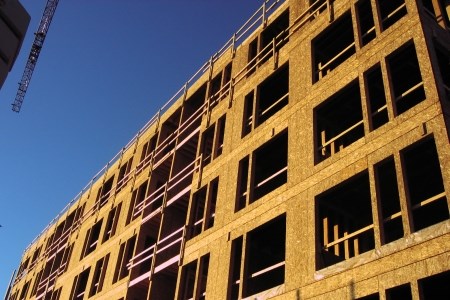Ontario is putting forward $7.8 million to back its previously announced Mass Timber Program, which will support research, education and construction related to tall wood buildings.
The province announced the funding in an April 25 news release, in which it said the use of timber in tall wood buildings could help address climate change by “storing carbon in buildings and by avoiding greenhouse gas pollution associated with other carbon-intensive materials.”
The program is part of the Climate Change Action Plan and is funded by proceeds from the province’s carbon market.
Of the funding, $3.15 million will go toward the research and development of the next generation of mass timber building systems. For this initiative, the province will partner with the Centre for Research and Innovation in the Bio-economy (CRIBE), the National Research Council, and FPInnovations.
Another $2.2 million will support specialized training for architects, engineers, designers, builders, educators and the trades. The province plans to partner with the College of Carpenters and Allied Trades and the Carpenters Union; Design Build Research; the Canadian Wood Council; and the University of Toronto, George Brown College, Lakehead University, Laurentian University, the University of Ottawa, and FPInnovations.
The final $2.45 million will be used to offset the costs of four mass timber building projects:
- George Brown College's Arbour development: planned to be a 12-storey building that will be the most carbon friendly building in Canada, constructed almost entirely of mass timber. It will house the college's School of Computer Technology and act as a living laboratory for students of mass timber construction.
- University of Toronto's Academic Tower: planned to be the tallest mass timber and concrete hybrid building in North America, this 14-storey building will act as a living laboratory for students learning skills in mass timber construction.
- Green Vision Development: planned to be a residential condominium complex consisting of three, 12-storey buildings in downtown North Bay. The first floor of these buildings, and their adjoining parking garages, will be constructed with concrete, and the remaining 11 storeys with wooden panels. These buildings will be used as living laboratories for students, and will contribute to the sustainability highlighted in North Bay's Master Plan.
- 57 Wade Avenue development: planned to be an eight-storey office building in Toronto. This building's construction will incorporate mass timber beams and an innovative floor assembly that will result in exposed wooden ceilings to the office space below.
The Mass Timber Program aims to:
- provide funding for research and development of innovative wood products, undertaken by academic and private research organizations, to support potential wood-related changes to the Building Code and other standards;
- fund post-secondary education institutions to provide skills development and technical training and to create tools relating to using wood in construction;
- support the establishment of a tall wood research institute in Ontario, in partnership with researchers, universities, and colleges; and
- demonstrate the successful use of mass timber in design, construction, and the fire safety of taller wooden buildings (seven storeys and higher) including four tall wood demonstration projects.
The current Building Code allows for the construction of wood frame buildings up to six storeys.
A Private Member’s Bill tabled by Nipissing MPP Vic Fedeli that would extend wood frame construction to buildings up to 14 storeys is slated for second reading in the provincial legislature on April 26.
Fedeli has said promoting wood frame construction would help boost the forestry sector in Northern Ontario.




